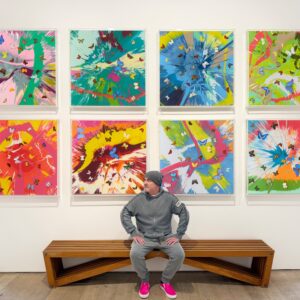IMPULSE Magazine launched this past summer amidst the throes of Donald Trump’s bid for re-election. Although their politics are polar opposites, the two do share one common fixation. Immigration. IMPULSE covers contemporary art with an activist bent geared towards gender and the lives of diasporic people, two matters that overlap and influence each other—and offer a richer, more human perspective on each artist’s practice. As America and the wider world prepare for another Trump presidency, IMPULSE’’s work is, of course, more pertinent than ever.

IMPULSE’s founder and editor in chief Xuezhu Jenny Wang has firsthand knowledge of the immigrant experience. She grew up in Dalian, an industrial port city in China, near the border with North Korea. “I moved to the US when I was 13 years old,” she said. “I moved to Mississippi first, and then to Florida. Both were for high school, and I would live with these host families.”
Wang went home to finish high school in 2019, and started her studio art degree at Columbia University the following year. But, because of COVID, she only moved to New York to attend the school in 2021. Wang already had a background painting landscapes inspired by the machinery scenery of her hometown. She quickly became disillusioned with the art world. Wang wound her way through comparative literature and architecture classes while working for galleries and nonprofits before landing a job in the art department at Harper’s Bazaar, pairing art with poetry and editorials. The impassioned, opinionated editors that Wang overheard from her desk day in and out led her to develop her own voice. After graduating in May, she chose to pursue writing.
While freelancing for the likes of Art Spiel and Whitehot Magazine, Wang met Cultbytes founder Anna Mikaela Ekstrand, who also directs New York’s Immigrant Artist Biennial. Ekstrand made Wang the writer-in-residence for the event’s 2024 edition. There, Wang met, interviewed, and wrote about immigrant artists from all over the world. “Lots of the artists I came across through that experience came here because of displacement, warfare. Some of them came here during their adulthood,” Wang said. “It was very fascinating to see how migration forms their practice.” Everyone was shaped by their legal status in some way, she found. Many dealt with anxiety.
A number of those artists also needed press coverage to secure their O1 visas, for professionals with special skills. “I wanted to support them, but it’s also a lot of work if I wanted to constantly pitch around to new editors,” Wang said. Writing does require a lot of time-consuming rejection. So, Wang started her own outlet. “There are social issues like feminism and human rights that I’m really passionate about, that I understand some bigger publications may not be able to cover due to their donors and due to their editorial scope,” she told me. “I was like, ‘I might as well.’”
She’s discovered that immigration and gender go hand in hand, too. “I’ve surprisingly found that the intersection between the two is increasingly popularized by media stereotypes,” Wang explained. “There’s always this whole fear about male violence versus female manipulation, the archetypes slash stereotypes, but then immigration exacerbates that element of fear.” Healthcare—of the reproductive and gender affirming varieties—adds another critical layer. “We as a magazine don’t always cover these two issues together, but I think highlighting one and the other is part of this whole mission of representing marginalized voices,” she continued musing.
Immigration is not just an American issue. Wang has witnessed an uptick in xenophobia even in the country she comes from—even though national borders are arbitrary inventions no other living creature abides by. The thing about the U.S., however, is that it espouses a ‘melting pot’ narrative without actually living by it. “When we have boundless cross border interactions and communications, maybe it’s really time to rethink this whole construct of borders,” Wang stated, adding that “just because we can’t think of a system that works doesn’t mean it doesn’t exist.”

That’s precisely the kind of creative problem solving art is good for, but art today is frequently ensnared in matters of the market. Not IMPULSE. Wang has unlearned her tendency to refer to artists by their medium or movement, instead focusing on their origins and stories. “At the end of the day, it’s really their background informing their practice,” Wang said. “More often than not, it’s easier to make your arts writing accessible to a wider public when it has a very personal tenor.” Transcending traditional art audiences, in fact, empowers art to make a much larger difference.
IMPULSE just finished a slight glow up. Their color scheme still centers on playful, energetic yellow, but their new mascot is a rabbit throwing side eye. It’s curious, slightly menacing, and also feminine, particularly given the Playboy association. IMPULSE has plenty more projects in the works, like a digital marketplace, an immigrant artist residency, and sustainability initiatives. Wang is also interested in leveraging social media graphics to help IMPULSE’s mission go viral.

Perhaps most importantly, IMPULSE has a chance to create community amidst the undoubtedly rocky times ahead. “Trump has been in office before, and generations of immigrants have survived before,” Wang said. “So this is not the first time, and it’s certainly not going to be the last. We just have to keep going and find a way forward.” IMPULSE has an opportunity to lead.
MORE: @impulse_magazine_







